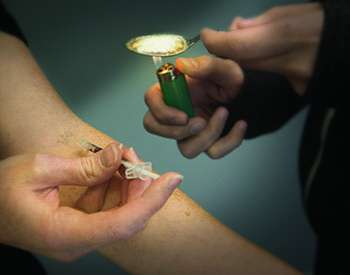New research at Washington University School of Medicine in St. Louis shows that drug abusers are not completely abandoning prescription painkillers for heroin. Many use both concurrently based on their availability. The findings also reveal regional variations in the use of heroin and prescription painkillers. Credit: Robert Boston
New research shows that drug abusers are not completely abandoning prescription opioids for heroin. Instead, many use the two concurrently based on their availability, according to a survey of 15,000 patients at drug-treatment centers in 49 states.
The findings, from researchers at Washington University School of Medicine in St. Louis, also reveal regional variations in the use of heroin and prescription painkillers. The research is published Oct. 29 in a letter in the New England Journal of Medicine.
"On the East and West coasts, combined heroin and prescription drug use has surpassed the exclusive use of prescription opioids," said senior investigator Theodore J. Cicero, PhD. "This trend is less apparent in the Midwest, and in the Deep South, we saw a persistent use of prescription drugs—but not much heroin."
Across the country in 2014, almost 42 percent of drug users in treatment reported they had taken heroin and prescription painkillers within a month of entering treatment, up from 23.6 percent in 2008, the researchers found.
"We see very few people transition completely from prescription opioids to heroin; rather, they use both drugs," he said. "There's not a total transition to heroin, I think, because of concerns about becoming a stereotypical drug addict."
A professor of neuropharmacology in psychiatry, Cicero said that although heroin has spread beyond inner cities into suburban and rural areas, many users still connote the drug with junkies they've seen depicted in movies and on television.
"People used to tell us quite often, 'At least I'm not using heroin,' when we asked about their drug abuse," Cicero said. "But in recent years, many have come to ignore that aversion, both because heroin is cheaper and accessible and because they've seen friends and neighbors use heroin."
Cicero's team conducted anonymous surveys when users entered drug treatment, asking about drugs of choice and patterns of use and abuse. Survey takers also had the option of giving up their anonymity to answer more detailed questions about their drug use. The study included detailed data from 267 such patients. Of them, 129 reported they had abused prescription opioids prior to heroin, and 73 percent cited factors such as cost and accessibility when explaining why they began using heroin.
The federal government's push to shut down "pill mills" and doctors illegally prescribing painkillers has made it harder to get prescription painkillers, Cicero said. For those who are addicted, heroin has been the supplement of choice.
"If users can't get a prescription drug, they might take whatever else is there, and if that's heroin, they use heroin," he said.
More information: Cicero TJ, Ellis M, Harney J. Shifting patterns of prescription opioid and heroin abuse across the United States. The New England Journal of Medicine, Oct. 29, 2015.
Journal information: New England Journal of Medicine
Provided by Washington University School of Medicine




















